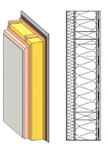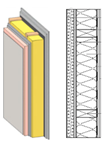MgO-Based Board Materials for Dry Construction Are a Tool for More Sustainable Constructions—Literature Study and Thermal Analysis of Different Wall Compositions
Abstract
:1. Introduction
2. Materials and Methods
3. Results and Discussion
3.1. Results
3.2. Discussion
3.2.1. LCA
3.2.2. Moisture Properties
3.2.3. Flexing, Static and Mechanical Properties
3.2.4. Resistance Properties
4. Conclusions
Author Contributions
Funding
Institutional Review Board Statement
Informed Consent Statement
Data Availability Statement
Acknowledgments
Conflicts of Interest
References
- Zaidi, S.A.H.; Zafar, M.W.; Shahbaz, M.; Hou, F. Dynamic linkages between globalization, financial development and carbon emissions: Evidence from Asia Pacific Economic Cooperation countries. J. Clean. Prod. 2019, 228, 533–543. [Google Scholar] [CrossRef]
- Maroušek, J.; Maroušková, A. Economic Considerations on Nutrient Utilization in Wastewater Management. Energies 2021, 14, 3468. [Google Scholar] [CrossRef]
- Sekar, M.; Kumar, T.P.; Kumar, M.S.G.; Vaníčková, R.; Maroušek, J. Techno-economic review on short-term anthropogenic emissions of air pollutants and particulate matter. Fuel 2021, 305, 121544. [Google Scholar] [CrossRef]
- Maroušek, J.; Maroušková, A.; Zoubek, T.; Bartoš, P. Economic impacts of soil fertility degradation by traces of iron from drinking water treatment. Environ. Dev. Sustain. 2021, 1–10. [Google Scholar] [CrossRef]
- Alwan, Z.; Jones, P.; Holgate, P. Strategic sustainable development in the UK construction industry, through the framework for strategic sustainable development, using Building Information Modelling. J. Clean. Prod. 2017, 140, 349–358. [Google Scholar] [CrossRef]
- Maroušek, J.; Maroušková, A.; Kůs, T. Shower cooler reduces pollutants release in production of competitive cement substitute at low cost. Energy Sources Part A Recovery Util. Environ. Eff. 2020, 1–10. [Google Scholar] [CrossRef]
- Mahmoud, S.; Zayed, T.; Fahmy, M. Development of sustainability assessment tool for existing buildings. Sustain. Cities Soc. 2019, 44, 99–119. [Google Scholar] [CrossRef]
- Doskočil, R.; Škapa, S.; Olšová, P. Success evaluation model for project management. E+M Ekon. Manag. 2016, 19, 167–185. Available online: http://hdl.handle.net/11025/22057 (accessed on 16 September 2021). [CrossRef]
- Stávková, J.; Maroušek, J. Novel sorbent shows promising financial results on P recovery from sludge water. Chemosphere 2021, 276, 130097. [Google Scholar] [CrossRef] [PubMed]
- Jandačka, J.; Holubčík, M. Emissions production from small heat sources depending on various aspects. Mob. Netw. Appl. 2020, 25, 904–912. [Google Scholar] [CrossRef]
- Coale, A.J.; Hoover, E.M. Population Growth and Economic Development; Princeton University Press: Berlin, Germany, 2015. [Google Scholar]
- Fang, C.; Liu, H.; Li, G. International progress and evaluation on interactive coupling effects between urbanization and the eco-environment. J. Geogr. Sci. 2016, 26, 1081–1116. [Google Scholar] [CrossRef]
- Azari, R.; Abbasabadi, N. Embodied energy of buildings: A review of data, methods, challenges, and research trends. Energy Build. 2018, 168, 225–235. [Google Scholar] [CrossRef]
- Korhonen, J.; Honkasalo, A.; Seppälä, J. Circular economy: The concept and its limitations. Ecol. Econ. 2018, 143, 37–46. [Google Scholar] [CrossRef]
- Devasahayam, S.; Strezov, V. Thermal decomposition of magnesium carbonate with biomass and plastic wastes for simultaneous production of hydrogen and carbon avoidance. J. Clean. Prod. 2018, 174, 1089–1095. [Google Scholar] [CrossRef]
- An, J.; Li, Y.; Middleton, R.S. Reducing energy consumption and carbon emissions of magnesia refractory products: A life-cycle perspective. J. Clean. Prod. 2018, 182, 363–371. [Google Scholar] [CrossRef]
- Slovak Magnesite Works (SMW), Joint Stock Company, Jelšava. CCM 85 (Feed Material—Magnesium Oxide—MgO) Product Code: 11.2.1 Calcined Magnesium Oxide Producer Registration Number: SK 400179. 2015. Available online: https://www.smzjelsava.sk/sites/default/files/ccm85-en-v4.pdf (accessed on 17 March 2021).
- Selmo 2018 Periclase Powder PPE-88 (Dnipro, Ukraine). Available online: https://selmo.com.ua/poroshok_periklazovyy_ppe-88/ (accessed on 12 September 2021).
- Swanson, G. Magnesium Oxide, Magnesium Chloride and Phosphate-based Cements (Austin, Texas, United States). 2010. Available online: http://www.greenhomebuilding.com/pdf/MgO-GENERAL.pdf (accessed on 12 September 2021).
- Magnesium Oxide Board (MgO Board) Market 2018–2023 Analysis, Segmentation and Forecast appeared first on America News Hour.
- Zhangjiagang Oriental Construction Material Co., Ltd. Innovative home building system OCM boards and Housing Panel.
- American MgO LLC. MagTech Ultra Magnesium Oxide Board—Environmental Product Declaration. 2018. Available online: https://assets.northamericanmgo.com/documents/MagTech-Ultra-EPD.pdf (accessed on 12 September 2021).
- Kibert, C.J. Sustainable Construction: Green Building Design and Delivery; John Wiley & Sons: Hoboken, NJ, USA, 2016. [Google Scholar]
- Lushnikova, N.; Dvorkin, L. Sustainability of gypsum products as a construction material. In Sustainability of Construction Materials; Woodhead Publishing: Sawston, UK, 2016; pp. 643–681. [Google Scholar]
- Zhong, R.Y.; Peng, Y.; Xue, F.; Fang, J.; Zou, W.; Luo, H.; Huang, G.Q. Prefabricated construction enabled by the Internet-of-Things. Autom. Constr. 2017, 76, 59–70. [Google Scholar] [CrossRef]
- Paolini, A.; Kollmannsberger, S.; Rank, E. Additive manufacturing in construction: A review on processes, applications, and digital planning methods. Addit. Manuf. 2019, 30, 100894. [Google Scholar] [CrossRef]
- STN 73 0540. Thermal Performance of Buildings and Components. Thermal Protection of Buildings. 2002. Available online: https://www.sutn.sk/eshop/public/standard_detail.aspx?id=128945 (accessed on 15 February 2021).
- Li, P.; Froese, T.M.; Cavka, B.T. Life cycle assessment of magnesium oxide structural insulated panels for a smart home in Vancouver. Energy Build. 2018, 175, 78–86. [Google Scholar] [CrossRef]
- Nielsen, S.W.; Rode, C.; Bunch-Nielsen, T.; Hansen, K.K.; Kunther, W.; Grelk, B. Properties of magnesium oxide boards used as sheathing in exterior walls. In MATEC Web of Conferences 2019; EDP Sciences: Les Ulis, France, 2019; Volume 282, p. 02091. [Google Scholar] [CrossRef]
- Rode, C.; Bunch-Nielsen, T.; Hansen, K.K.; Grelk, B. Moisture damage with magnesium oxide boards in Danish facade structures. Energy Procedia 2017, 132, 765–770. [Google Scholar] [CrossRef] [Green Version]
- Aiken, T.A.; Russell, M.; McPolin, D.; Bagnall, L. Magnesium oxychloride boards: Understanding a novel building material. Mater. Struct. 2020, 53, 118. [Google Scholar] [CrossRef]
- Gravit, M.; Zybina, O.; Vaititckii, A.; Kopytova, A. Problems of magnesium oxide wallboard usage in construction. In Energy Management of Municipal Transportation Facilities and Transport; Springer: Belgrade, Serbia; Cham, Switzerland, 2017; pp. 1093–1101. [Google Scholar] [CrossRef]
- Hansen, K.K.; Bunch-Nielsen, T.; Grelk, B.; Rode, C. Magnesium-oxide boards cause moisture damage inside facades in new Danish buildings. In International RILEM Conference on Materials, Systems and Structures in Civil Engineering; Rilem Publications: Paris, France, 2016; pp. 151–161. [Google Scholar]
- Jays, N.; Olofinjana, A.; Young, D.J. Assessing variability in the hygrothermal performance of magnesium oxide (MgO) cladding products of the Australian market. Constr. Build. Mater. 2019, 203, 491–500. [Google Scholar] [CrossRef]
- Nghana, B.; Tariku, F. Field investigation of moisture buffering potential of american clay and magnesium oxide board in a mild climate. J. Archit. Eng. 2018, 24, 04018023. [Google Scholar] [CrossRef]
- Smakosz, Ł.; Kreja, I. Failure mode prediction for composite structural insulated panels with MgO board facings. In AIP Conference Proceedings; AIP Publishing LLC: Melville, NY, USA, 2018; Volume 1922, p. 050004. [Google Scholar] [CrossRef]
- Zheng, N.; Wu, D.; Sun, P.; Liu, H.; Luo, B.; Li, L. Mechanical properties and fire resistance of magnesium-cemented poplar particleboard. Materials 2019, 12, 3161. [Google Scholar] [CrossRef] [PubMed] [Green Version]
- Smakosz, Ł.; Kreja, I.; Pozorski, Z. Flexural behavior of composite structural insulated panels with magnesium oxide board facings. Arch. Civ. Mech. Eng. 2020, 20, 105. [Google Scholar] [CrossRef]
- Sonkar, C.; Mittal, A.K.; Bhattacharyya, S.K. Comparative Study on Cold-Formed Steel Single-Stud and Multiple-Studs Wall Panels with Magnesium Oxide Sheathing under Axial Loading: Experimental and Analytical. J. Struct. Eng. 2020, 146, 04020224. [Google Scholar] [CrossRef]
- Dewangan, A.; Bhatt, G.; Sonkar, C. Analytical assessment of CFS wall-panels sheathed with MgO board. In Proceedings of the International Colloquia on Stability and Ductility of Steel Structures (SDSS 2019), Prague, Czech Republic, 11–13 September 2019; p. 337. [Google Scholar]
- Manalo, A. Structural behaviour of a prefabricated composite wall system made from rigid polyurethane foam and Magnesium Oxide board. Constr. Build. Mater. 2013, 41, 642–653. [Google Scholar] [CrossRef]
- Aiken, T.A.; McPolin, D.; Russell, M.; Madden, M.; Bagnall, L. Physical and mechanical performance of magnesium-based construction boards: A comparative study. Constr. Build. Mater. 2021, 270, 121397. [Google Scholar] [CrossRef]
- Rusthi, M.; Ariyanayagam, A.; Mahendran, M.; Keerthan, P. Fire tests of Magnesium Oxide board lined light gauge steel frame wall systems. Fire Saf. J. 2017, 90, 15–27. [Google Scholar] [CrossRef] [Green Version]
- Martins, J.A.; Gomes, C.M.; Fontanini, P.; Dornelles, K. Comparative analysis on thermal performance of MgO and fiber cement boards applied to light steel frame building systems. J. Build. Eng. 2019, 21, 312–316. [Google Scholar] [CrossRef]
- Gnanachelvam, S.; Ariyanayagam, A.; Mahendran, M. Fire resistance of LSF wall systems lined with different wallboards including bio-PCM mat. J. Build. Eng. 2020, 32, 101628. [Google Scholar] [CrossRef]
- Ye, J.; Wang, X.; Jia, H.; Zhao, M. Cyclic performance of cold-formed steel shear walls sheathed with double-layer wallboards on both sides. Thin-Walled Struct. 2015, 92, 146–159. [Google Scholar] [CrossRef]
- Chen, W.; Ye, J.; Bai, Y.; Zhao, X.L. Improved fire resistant performance of load bearing cold-formed steel interior and exterior wall systems. Thin-Walled Struct. 2013, 73, 145–157. [Google Scholar] [CrossRef]
- Antošová, N.; Belániová, B.; Chamulová, B.; Janušová, K.; Takács, J. The protection of environment during cleaning ETICS with biocides. In Advances and Trends in Engineering Sciences and Technologies III; CRC Press: Boca Raton, FL, USA, 2019; pp. 281–286. [Google Scholar]
- Belániová, B.; Antošová, N. Technology of Double Thermal Insulation for the Repair and Energy Optimization of Existing Thermal Insulation Composite Systems. Sci. Pap. J. Civ. Eng. 2017, 12, 97–108. [Google Scholar]
| Variant 1 | Variant 2 | Variant 3 | ||
|---|---|---|---|---|
| A |  |
|
|
|
| B |  |
|
|
|
| C |  |
|
|
|
| Variant 1 | Variant 2 | Variant 3 | Variant 4 | ||
|---|---|---|---|---|---|
| D |  |
|
|
|
|
| E |  |
|
|
|
|
| F |  |
|
|
|
|
| Variant 1 | Variant 2 | Variant 3 | |
|---|---|---|---|
| A | 6.555 * 0.152 ** | 6.561 * 0.152 ** | 6.568 * 0.152 ** |
| B | 6.469 * 0.154 ** | 6.618 * 0.151 ** | 6.497 * 0.153 ** |
| C | 7.683 * 0.130 ** | 7.697 * 0.129 ** | 7.711 * 0.129 ** |
| Variant 1 | Variant 2 | Variant 3 | Variant 4 | |
|---|---|---|---|---|
| D | 0.222 * 4.504 ** | 0.286 * 3.496 ** | 0.254 * 3.937 ** | 0.238 * 4.201 ** |
| E | 1.894 * 0.527 ** | 1.958 * 0.510 ** | 1.926 * 0.519 ** | 1.910 * 0.523 ** |
| F | 2.950 * 0.338 ** | 3.076 * 0.325 ** | 3.016 * 0.331 ** | 2.982 * 0.335 ** |
Publisher’s Note: MDPI stays neutral with regard to jurisdictional claims in published maps and institutional affiliations. |
© 2021 by the authors. Licensee MDPI, Basel, Switzerland. This article is an open access article distributed under the terms and conditions of the Creative Commons Attribution (CC BY) license (https://creativecommons.org/licenses/by/4.0/).
Share and Cite
Švajlenka, J.; Kozlovská, M.; Mokrenko, D. MgO-Based Board Materials for Dry Construction Are a Tool for More Sustainable Constructions—Literature Study and Thermal Analysis of Different Wall Compositions. Sustainability 2021, 13, 12193. https://doi.org/10.3390/su132112193
Švajlenka J, Kozlovská M, Mokrenko D. MgO-Based Board Materials for Dry Construction Are a Tool for More Sustainable Constructions—Literature Study and Thermal Analysis of Different Wall Compositions. Sustainability. 2021; 13(21):12193. https://doi.org/10.3390/su132112193
Chicago/Turabian StyleŠvajlenka, Jozef, Mária Kozlovská, and Daria Mokrenko. 2021. "MgO-Based Board Materials for Dry Construction Are a Tool for More Sustainable Constructions—Literature Study and Thermal Analysis of Different Wall Compositions" Sustainability 13, no. 21: 12193. https://doi.org/10.3390/su132112193
APA StyleŠvajlenka, J., Kozlovská, M., & Mokrenko, D. (2021). MgO-Based Board Materials for Dry Construction Are a Tool for More Sustainable Constructions—Literature Study and Thermal Analysis of Different Wall Compositions. Sustainability, 13(21), 12193. https://doi.org/10.3390/su132112193







